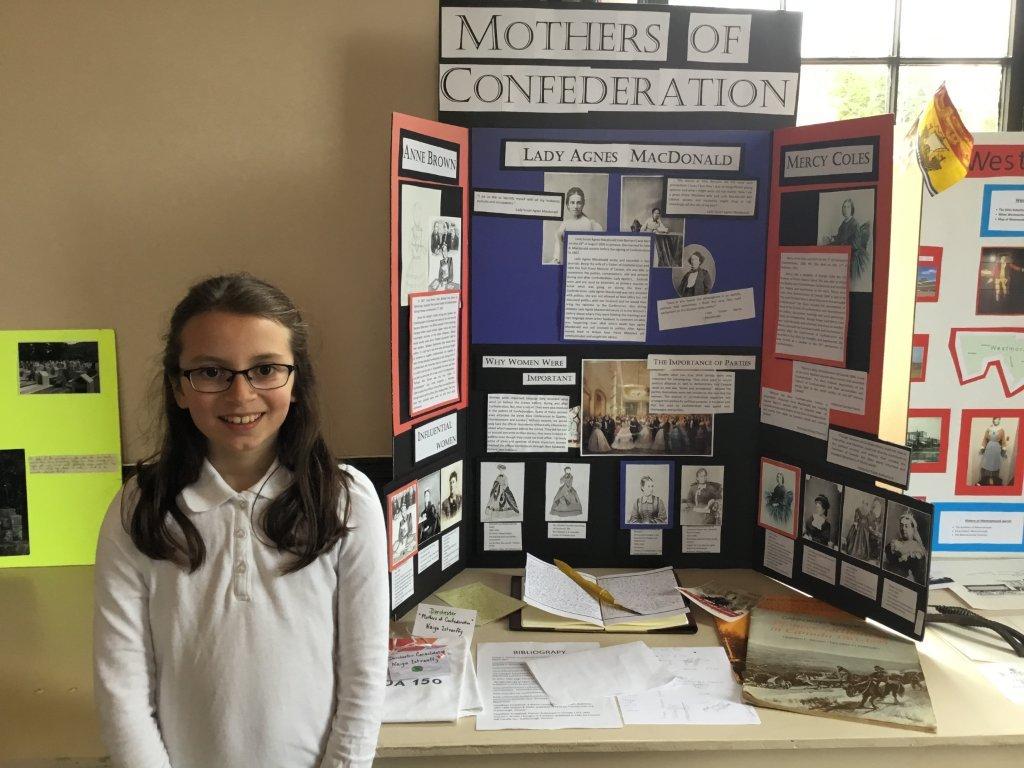The Albert County Museum was bustling with activity on Wednesday, May 10 as Anglophone East students came to spend the day participating in the 2017 Regional Heritage Fair.
Students from five middle schools proudly displayed their creative and innovative heritage projects of varied themes and project categories in the Community Hall. Judges interviewed the students and assessed the projects based on specific evaluation criteria for the special juried awards, as well as other prizes. But, the day included much more than the judging!
Enrichment activities included each student “Painting a Mosaic Tile”. This activity is part of a Canada 150 project which will result in a large mosaic being created by a professional artist using the painted tiles from all the Regional Heritage Fairs throughout the school districts in the province. The finished provincial mosaic will then be displayed at Government House in Fredericton.
In the historic Courthouse built in 1904, the students also enjoyed the presentation of historical vignettes by the summer students from the William Henry Steeves House Museum in Hillsborough. The costumed actors portrayed the inhabitants of the Albert County region of Canada, beginning with the Aboriginal Mi'kmaq, then the Acadians, followed by the German immigrants of the Stief family, and English loyalists. The last vignette portrayed the celebration of Dominion Day, July 1, 1867.
This year the RHF students were present for the special ceremonial planting of a Vimy oak tree presented to the Museum by the Vimy Foundation. The students learned of the significance of the Vimy oak tree being planted at the Albert County Museum. At the Museum is a WWI German K-14 cannon captured by a Canadian Battalion at the Battle of Vimy Ridge on April 9, 1917. The German cannon, a war trophy of Canada, was awarded to Albert County for winning the Victory Loan campaign of 1919.
Following the planting of the Vimy oak tree, the Awards Ceremony took place in the Courthouse.
The following students were recipients of the Regional Heritage Juried Awards and other prizes.
Naiya Istvanffy, grade 5 student from Dorchester Consolidated School, received the Provincial Showcase Award. Naiya was selected to represent ASD-E with her project “The Mothers of Confederation” at the Provincial Heritage Fair to be held June 23-25 at the Albert County Museum, Hopewell Cape, NB.
Naiya Istvanffy also received the Young Citizen's Award so she will be creating a 2-3 minute video about her project to be submitted to the History Society of Canada website.
Dominick Fournier (Dorchester Consolidated) received the NB Historic Places Award for his project “The History of Westmorland”.
Kassi Stuart (Riverview East) received the NB St. Croix Award for her project “Blockhouses and Forts of New Brunswick”.
Cadence Nelson (Dorchester Consolidated) received the NB Aboriginal Affairs Award for her project about The Maliseet Tribe and First Nations”.
Megan MacAulay (Evergreen Park) received the NB Provincial Commemorations Award for her project “The Ganong Family”
A, Jane Martin ( Riverview East) received the NB Museum Award of Merit for her project “Miramichi Fire of 1825”
Sarah MacAulay (Evergreen Park) received the Council of NB Archives Award for her project “Le Pont de la Confédération”.
Jake Purdy and Elliot Hicks (Dorchester Consolidated) received the NB Sport Legacy Award for their project on “Lacrosse”.
Sally Kim (Riverview East) received the NB Labour History Award for her project “Ganong”.
Lexa Kwan (Evergreen Park) was awarded the Canada's History medal for her project “Les événéments et les personnes qui ont mené a la création du drapeau Canadien”.
Liam Haynes (Evergreen Park) received the NB Military History Award for his project “Speech About the Battle of Vimy Ridge”.
Three Royal Canadian Legion Military History Medals were awarded to Natalie Thompson, Caylin Carson and Haley Batson from Port Elgin Regional for their project “The War of 1812”.
The Albert County Museum prizes were awarded to Molly Dixon (Port Elgin Regional) for project “Vimy Ridge”and to Landon Stevens, Ben Bouchard, Ryan Milburn and Alexander MacFarlane (Caledonia Regional) for “Sugar Woods” project.
Prizes from Resurgo, Moncton were awarded to Jonathan Field (Riverview East) for project “Covered Bridges of NB”
Special prizes from Fort Beausejour-Fort Cumberland were awarded to Joris Jakob and Aiden Sweeney (Port Elgin) for their project “Acadian Farming”.
Honorable mention prizes were awarded to Robbie Harker and Hunter Pepper (Port Elgin) for project “The Confederation Bridge”; to Breeze Tingley and Hailey Tingley (Caledonia Regional) for project “Gray's Island” and to Olivia NcGrath (Caledonia Regional) for project “Multiculturalism”.
Submitted by Dawne McLean, ASD-E RHF Coordinator

